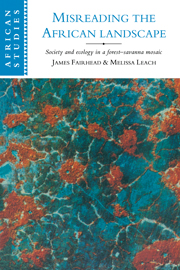Book contents
- Frontmatter
- Contents
- List of plates
- List of figures
- List of tables
- Note on authorship and research collaboration
- Acknowledgements
- Linguistic conventions
- Introduction
- 1 Convictions of forest loss in policy and ecological science
- 2 Forest gain: historical evidence of vegetation change
- 3 Settling a landscape: forest islands in regional social and political history
- 4 Ecology and society in a Kuranko village
- 5 Ecology and society in a Kissi village
- 6 Enriching a landscape: working with ecology and deflecting successions
- 7 Accounting for forest gain: local land use, regional political economy and demography
- 8 Reading forest history backwards: a century of environmental policy
- 9 Sustaining reversed histories: the continual production of views of forest loss
- 10 Towards a new forest–savanna ecology and history
- Appendix I Glossary of plant names
- Appendix II Cassette recordings of oral accounts and discussions
- Notes
- List of references
- Index
- Titles in the series
- Plate section
2 - Forest gain: historical evidence of vegetation change
Published online by Cambridge University Press: 05 June 2012
- Frontmatter
- Contents
- List of plates
- List of figures
- List of tables
- Note on authorship and research collaboration
- Acknowledgements
- Linguistic conventions
- Introduction
- 1 Convictions of forest loss in policy and ecological science
- 2 Forest gain: historical evidence of vegetation change
- 3 Settling a landscape: forest islands in regional social and political history
- 4 Ecology and society in a Kuranko village
- 5 Ecology and society in a Kissi village
- 6 Enriching a landscape: working with ecology and deflecting successions
- 7 Accounting for forest gain: local land use, regional political economy and demography
- 8 Reading forest history backwards: a century of environmental policy
- 9 Sustaining reversed histories: the continual production of views of forest loss
- 10 Towards a new forest–savanna ecology and history
- Appendix I Glossary of plant names
- Appendix II Cassette recordings of oral accounts and discussions
- Notes
- List of references
- Index
- Titles in the series
- Plate section
Summary
Ecological arguments about changes in the pattern of vegetation in the forest–savanna mosaic, as reviewed in the previous chapter, have rarely been based on historical analysis. Instead, they have relied mainly on analyses of vegetation form and short-term process, and on deducing longer-term change from these. Where historical sources have been used – for example in examining past and present air photographs – the timescale of analysis has generally covered only 10–15 years (Morgan and Moss 1965, Grégoire et al. 1988). In Kissidougou, assessments of vegetation change have never drawn on historical data sets in more than a cursory way. Yet these are available: in air photographs covering the past forty years; in the written observations of visitors and administrators at the turn of the century, and in the recollections of the prefecture's elderly inhabitants. In this chapter we use these historical sources to detail vegetation change in the prefecture during the past century; the period over which, as we have seen, policy-makers have unanimously agreed that forest cover has been in decline and savannas spreading. The story revealed by the historical record is strikingly different, and supportive of ecological and local management possibilities which, at least in Kissidougou's policy circles, have never been considered.
Documenting the vegetation history of the forest–savanna mosaic, and distinguishing it from the diverse representations of it, is fraught with methodological difficulties.
- Type
- Chapter
- Information
- Misreading the African LandscapeSociety and Ecology in a Forest-Savanna Mosaic, pp. 55 - 85Publisher: Cambridge University PressPrint publication year: 1996



